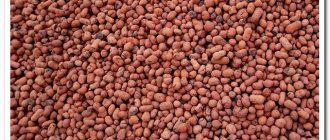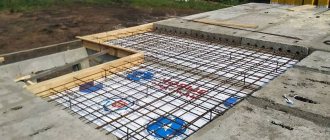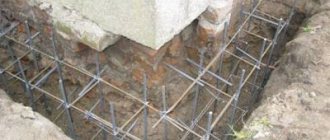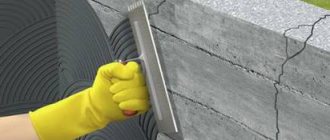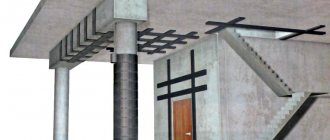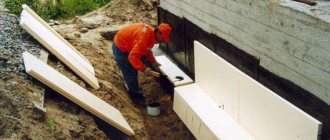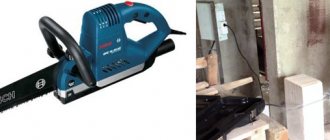In the processing and mining industries, devices for crushing fairly large pieces of material and obtaining fractions of the required sizes are widely used. These devices were invented back in the 18th century and, having gone through a fairly long path of modifications and improvements, are successfully used today. The device is quite simple, so you can make a crusher for crushed stone with your own hands, but at the same time durable, which allows it to be used in construction, mining and other industries.
Cone design diagram
The main methods for producing expanded clay gravel
The word “expanded clay” itself translated from Greek means “burnt clay”. Already from this name it is clear that to obtain expanded clay, clay must be fired. The essence of the technological process comes down to the following: the prepared clay is subjected to sharp thermal shocks, which makes it possible to achieve porosity of the material and its swelling. Thanks to the melting of the outer shell, the expanded clay is sealed and acquires high strength.
Material Certification
Since the technology for producing expanded clay is quite labor-intensive and complex, any violations can negatively affect the quality of the products. Therefore, when purchasing, be sure to read the certificate of conformity.
There is GOST 9759-76, which specifies the requirements for the parameters of granules, weight and strength of expanded clay. Strength is the main indicator that is taken into account when admitting a material into operation.
Expanded clay is an important component of expanded clay concrete, and no company producing lightweight concrete will purchase it without the necessary documents. In addition, it is widely used in the construction industry. The certificate of conformity provides information about the environmental safety of the material, its compliance with sanitary standards, and provides recommendations regarding storage and transportation.
Main indicators for certification of various fractions of expanded clay
Features of production technology
The raw materials for producing expanded clay are predominantly sedimentary clay rocks, less often metamorphic rocks (argillite, shales and other stone-like rocks).
They have a complex composition and include both clay minerals (hydromica, kaolinite, etc.) and feldspar, quartz, carbonates, organic and ferruginous impurities.
What is this building material made of? The best clays for making expanded clay are those that contain a maximum of 30% quartz.
Whether a particular material is suitable for production is determined through special research. Main requirements for raw materials:
Sometimes special additives are added to the raw material to increase the swelling coefficient. Organic (solar oil, fuel oil, etc.), ferrous substances, rocks (perlite, alunite, etc.) or artificial substances can be used as an additive.
As a result of processing the feedstock, raw granules of a certain size and composition are obtained. These granules can be heat treated: they are dried, fired and cooled. At the next stage, the resulting material is sorted by density and, if necessary, crushed into smaller fractions. After sorting, expanded clay is ready for storage or shipment to the place of use.
The main stages of expanded clay production:
Main types of such equipment
The crushed stone and hard rocks used have compressive resistance values from 300 to 1200 MPa. To successfully crush such stones, it is necessary to use crushers that are specially designed. Augers are a universal type that can work with rock of any strength. The crushing of the material is carried out by two heavy plates, one of which is permanently fixed, and the second moves and compresses the rock. The upper clearance of the auger can be adjusted, which allows the use of rocks of different origins. Also, modern installations allow you to regulate the size of the fraction obtained at the output. At the same time, it should be noted that this type of crushers is characterized by increased demands on the frequency of maintenance and may often require qualified repairs. During operation, it will be necessary to change places of work plates, which may wear out unevenly and subsequently require expensive replacement. However, it is possible to use work plates with linings made of durable wear-resistant metal. Among the disadvantages of such crushers, one can note the increased flakiness of crushed stone, which somewhat deteriorates the quality of the resulting material.
Cone crushers have a design similar to auger crushers, but the working element is not plates, but a special three-dimensional shape. The balanced shaft rotates at high speed and allows you to break the rock, resulting in crushed stone with a characteristic cubic shape. This type of equipment is characterized by performance and reliability. Today, such cone crushers have proven themselves to be the most reliable and easy to operate. A special system allows you to change the size of the crushed stone fraction obtained at the output. At the same time, it is necessary to note their increased dimensions, which often does not allow the production of crushers in a mobile version.
Rotary crushers can be used to produce crushed stone of the smallest fractions. Such equipment has a complex design and splits rock with powerful blows. Subsequently, the crushed stone is further crushed to the required fraction. It should be said that this type of equipment does not allow high-quality control of the fraction size. We also note that there are restrictions on the hardness of the material, which does not allow the use of hard rocks for work. Roller crushers can be used to produce medium and fine crushed stone. In equipment of this type, rolls rotating towards each other are used to destroy rock. It is recommended to use this type of equipment with medium-hard rock.
Extraction of feedstock
The expanded clay production process begins with the extraction of clay raw materials in quarries and its transportation to the clay reserve. Development is carried out using open-pit mining using single- and multi-bucket excavators. Extraction of raw materials is carried out along the entire height, without isolating individual layers.
To ensure continuous production of expanded clay, special frost-resistant clay storage facilities are installed that can hold about a six-month supply of material. Intermediate cones are also used to store clay, in which it is kept in the open air for several months.
Due to the influence of temperature, periodic wetting and drying, the natural structure of the material is partially disrupted. This greatly facilitates the process of further processing of raw materials into a homogeneous mass.
Methods for producing expanded clay granules
There are four main methods for making expanded clay, which differ in their technology:
The choice of a specific method depends on the quality of the raw materials.
Dry method
This method is the simplest. It is used when dealing with stone-like raw materials. First, it is crushed, then sent to a rotary kiln. This method is most effective if the rock is homogeneous, without harmful inclusions. It is characterized by low costs and low energy consumption.
Wet (or slip) method
Clay is placed in large containers - clay stompers. Then it is diluted with water, obtaining a slip with a moisture content of about 50%. It is pumped into a slurry basin, from where it is transferred to a rotary kiln. Here it is broken down into individual granules. They are dried by the gases that come out of the oven.
The wet method requires high fuel consumption because the slip has high humidity. However, it allows you to clean the raw material from rocky inclusions, introduce additives into it, and obtain a homogeneous mass. It is used in case of high humidity of the feedstock.
The video will tell you in more detail how expanded clay gravel is made using the example of wet production:
Plastic method
This method is most common in the production of expanded clay. It involves moistening loose raw materials and processing them in rollers or clay mixers. The process of making expanded clay is similar to making bricks.
From the resulting mass, cylindrical granules are formed on perforated rollers or belt presses, which are later given a spherical shape. The granules are immediately sent to a rotary kiln or additionally dried in special drums.
The plastic method is more complex, energy- and capital-intensive than the dry method, but it allows you to make a material with better properties. During processing, the natural structure of the raw material is disrupted, it is homogenized, and therefore has a higher swelling coefficient.
Powder-plastic method
First, the dry raw material is brought to a powder state, then diluted with water. As a result, a plastic mass is obtained from which granules are formed. This method is quite expensive, since it is necessary to additionally grind the material. Another disadvantage is the need for additional drying of the granules.
Source
Options for making a crusher yourself
A crusher is a unit that is supposed to crush rocks. Today, the list of materials exposed to crushers has been expanded. From brick to plastic, from cardboard to tires, from expanded clay to foam rubber - there is a request for every action. It is noteworthy that you can make such crushers yourself: it will be less expensive, and you will have one hundred percent confidence in the quality of the device.
Types of stone crushers
To properly establish the production process, you need to select the right type of crusher, since there are different types with characteristic technical and functional features:
- Hammer crusher for stone . A hammer crusher is a special device that breaks stone into the desired shape and structure. The hammer blows are cyclical, so the stone breaks into the required pieces, eliminating any inaccuracies and inconveniences. The absence of a large amount of waste is considered an important advantage.
- Cone crusher. This device allows you to easily and simply cope with crushing stone material, while providing the appropriate convenience. The system consists of two cones, between which there is space for moving stones for the purpose of crushing them.
- Impact crusher. The device is ideal for crushing hard and soft rocks. Crushing is carried out due to the rotor in the system, which is characterized by high power, reliability, quality and, most importantly, technical serviceability. The absence of inaccuracies reduces the amount of waste and material rejection.
- Roller crusher. The device is equipped with special shafts that rotate among themselves to crush stone and hard rocks. The devices rotate towards each other, due to which crushing is carried out evenly and efficiently, eliminating any technical inaccuracies.
- Lye crusher. The design of the device contains rectangular slabs through which the stone passes to crush and obtain the desired shape and appearance. The working space is wedge-shaped for convenient movement of the stone in order to obtain the desired structure.
Homemade brick crusher
There are also shaft crushers: two cylindrical shafts rotate at equal speed towards each other.
Finally, they get down to business with a grinder with a hammer mechanism - the brick is destroyed with a hammer.
Let us list the design nuances of a homemade brick crusher.
Taking these fundamental points into account, you can make a crusher yourself. This is a container with a shaft on bearings, on legs. An alternative can be a cone crusher: these are two large cones located opposite each other.
The crusher starts up, and the cones begin to sequentially destroy the material.
Installation of equipment
All parameters of shredders, as a rule, are given in special documentation, which is supplied complete with the equipment itself. In addition, all the main characteristics of the device are printed on a special nameplate, which is located on the case.
In everyday life and, of course, in the household, mechanisms that are made by hand from scrap materials are often used.
That is, you may need:
- engine;
- special knives that can be purchased on the construction market;
- container (optional, but keep in mind that it must be durable, for example, an iron barrel);
- belt;
- bearings;
- shaft;
- wrenches and screwdriver.
A do-it-yourself crusher for crushed stone (shredder), in its most primitive design, is a kind of container in which a shaft with a single or several sharp knives is mounted on bearings.
https://youtu.be/Ig5O7dbHxks
- The shaft drives a low-power electric motor, which, as a rule, does not exceed 1 kW, through a belt drive with several wheels of different diameters, which makes it possible to adjust the shaft rotation speed.
How to make a plastic crusher?
The system for crushing plastic bottles and other similar items is built on the inclusion of circular saws (about 20 pieces), an electric motor, an axis intended for fastening saws, a metal profile, various fastening elements, as well as a hopper, a belt, a pulley and several bearings.
The process of creating a low-cost crushing system for plastic products involves seven steps.
If you have a drawing in front of your eyes, the risk of making a mistake is minimized. In principle, the device is simple - everyone should be able to do it.
Nuances of preparation and assembly
- Before actual assembly, do not be too lazy to draw a small drawing - this will clarify certain aspects of the assembly and avoid problems when creating the device.
- For high productivity of the device, it is necessary to install as many cutting disks as possible (up to 25 pieces) with a thickness of 0.1 m.
- When working with harder materials than wood, it is best to use a motor unit instead of an electric motor, as its power is much higher.
- If you don’t want to worry about periodically sharpening the machine’s cutters, purchase wheels with alloy attachments.
- To create pressure on the material during the grinding process, a block should be attached to the structure opposite the hopper.
Step-by-step instructions for creating a garden model
Every gardener knows what spring pruning of trees is. And he knows that after it a new problem appears - where to put the branches. You can make compost out of them, of course, but there is a way to get it much faster than just throwing the branches (as they are) into the compost pile. They just need to be crushed, then the compost can ripen within a season, or even faster.
To build a garden shredder you need to prepare:
Once everything is in front of you, you can move on to the creation process itself.
What’s good about a homemade shredder is its reliability and operation, as they say, without undue embarrassment. It will do an excellent job with the same branches, and with other household garbage, and crushing fruits (directly with seeds). Finally, self-production is also a matter of saving. A homemade product, even if it breaks at some point, will not require the purchase of a specific expensive part (as will happen with a store-bought crusher); it can be repaired with something readily available, inexpensive, and available on the farm.
Expanded clay crusher.
I looked all over the net and on the website and couldn’t find anything suitable. The task is to crush expanded clay to a fraction of max 10mm. The required consumption volumes are small, so large and expensive installations are not suitable. Please advise me, something compact and inexpensive, maybe someone produces it in Ukraine, give me the address or throw in a drawing, your hands are not good. maybe I'll do it myself.
Hello1 Sergey Ivanovich, your grandmother had a factory crusher. I found and restored a cone crusher, but I couldn’t find its description or true purpose.
| Quote |
| Soltis Pavel writes: I can take photos. |
Please be kind
| Quote |
| Soltis Pavel writes: Good day. I can recommend Kulibin, who made me a crusher for expanded clay. The crusher is simple - 2 shafts (the distance between the shafts is adjustable), with inclusions deposited on the shafts (like these minimal “spikes”), a motor turns the shafts through a gearbox, on top there is a conical bunker above the shafts, into which expanded clay is thrown - that’s all. This is the second year we have been crushing - about 10 cubic meters a day (but we are crushing only before lunch). I can say that it’s very good. This miracle cost 1400 USD 2 years ago. If you're interested, I can take photos. |
Do you think this design would be suitable for crushing crushed stone: 5-25 by 5-15 (10), small volume - 1-2 cubic meters per day. There is a shaft from the conveyor available (powerful, approx. 70 cm, length dia. 30-35 cm + gearbox for it ts3u). I just look at how the mixer (regular SB-80) is crushing crushed stone, and the thought arises that 2 powerful rollers plus a 5.5 kW engine should cope
We need a crusher for crushing coarse expanded clay into a smaller fraction. A new one costs 40,000-75,000 rubles. I would like to make it myself. Maybe someone has drawings, photographs of such a crusher or has one in stock. Photo of the crusher is attached.
Here is a link to a video of the expanded clay crusher in operation:
| Quote |
| Shmel writes: We need a crusher for crushing coarse expanded clay into a smaller fraction. A new one costs 40,000-75,000 rubles. I would like to make it myself. Maybe someone has drawings, photographs of such a crusher or has one in stock. Photo of the crusher is attached. |
Here is a link to a video of the expanded clay crusher in operation:
Source
Other designs
There are different crushers, their main difference from each other is the processed material. There is a fundamental difference between a machine that shreds cardboard or foam rubber, and a machine that is suitable for rubber (tires, tires) or, for example, expanded clay. Crushers are also made to crush bird bones. You can make a glass grinding machine yourself.
Use elements of used equipment: washing machine, meat grinder, grinder, etc. The main thing is that the principle of operation of the device is observed . Figuratively speaking, this is the principle of a meat grinder, in which the material passes through the drum/reception bowl, ends up in the crushing system and is effectively crushed. The department where the material is ground is represented by cutters and a milling cutter. The raw material will be processed until it reaches the required grinding size.
For example, until it becomes metal shavings or sawdust
With the help of a gear-rotor crusher you can crush even asphalt and clay. The roller system is most often used for grain processing. And there are a great many examples of such structures. But if you look at the step-by-step instructions for making a garden crusher, a device for any other material will be made according to the same basic plan. Only its power, size, number of saws, etc. will change.
See the video below for options for making a crusher with your own hands.
Source
How to use a homemade crusher?
A homemade grinding apparatus is considered a universal device.
Working with a homemade crusher is not limited to processing leaves or other small debris. A high-quality device, created according to the above instructions, is capable of processing wood and household waste. The described design, based on a horizontal arrangement of cutting discs, is more reliable in terms of durability. In factory versions of crushers, saws are installed vertically , which forces the user to constantly monitor the moisture content of the stems entering the machine. Wet raw materials contribute to the breakdown of devices with this arrangement of saws.
Making a homemade shredder allows you to select the required engine power that matches the material being processed.
Thus, with a little imagination and dexterity, you can achieve amazing results. After all, while your neighbor is saving up for an expensive crusher, you will already be making full use of the technical “fruit” of your efforts. Thanks to high-quality assembly, a homemade grinding apparatus can become a universal machine for crushing many materials, including hard ones.
Source
Composition and characteristics
Expanded clay contains clay and its shale; the manufacturing process takes place by firing the initial raw material mass in special furnaces
At a temperature of 1,000 - 1,300 degrees, the clay swells and goes into a pyroplastic state. Taking into account the quality of the source material, the created temperature regime, the duration of the firing process and other technological features of manufacturing, different technical indicators of the material are obtained, the most significant of which are grain sizes, density and volumetric weight.
The parameters of expanded clay are determined by GOST, which regulates the quality indicators of building materials with a porous structure. Some indicators are not regulated, but they still remain important characteristics. Let's look at the main properties in more detail:
Features of manufacturing technology
With the help of special studies of the feedstock, its suitability for the production of expanded clay is determined. The main requirements for the initial material are:
The result of processing raw materials are raw granules with a certain size and composition. They are first dried, then fired and cooled. At the next stage of production, the material is sorted by density and, if necessary, crushed to produce smaller fractions. At the end of everything, the expanded clay is sorted, stored or shipped for shipment.
The whole process in its essence is as follows: after preparation, the clay is subjected to thermal shock, which gives it porosity and promotes the swelling process. Due to the melting of the shell, expanded clay receives sealing and becomes durable.
Fractionation and transportation
For fractionation, drum screens are used, which have a cylindrical or multifaceted shape.
Expanded clay is transported within the plant pneumatically or via a belt conveyor. The conveyor method is more popular, since transportation through pipes using air flow leads to damage to the shell and crushing of the granules.
The finished material is stored in a silo or bunker type warehouse. To do this, expanded clay is pre-packed in special moisture-proof bags of various sizes.
Extraction of feedstock
The production process begins with the extraction of raw material by quarrying and its transportation to clay reserves. Development is carried out in an open way, using single- and multi-bucket excavators. Individual layers are not identified; production occurs throughout the entire height.
When extracting stone-like rocks in the form of mudstone and clay shales, drilling and blasting operations are used. Such breeds can be developed at any time of the year, while soft breeds can only be developed during the appropriate period.
To ensure that the production process continues uninterruptedly, special frost-resistant clay storage facilities are built to hold a six-month supply of raw materials. You can use intermediate cones for storage, in which the clay is kept in the open air for several months.
Production of expanded clay
Under the influence of temperature, periodic wetting and drying, the structural structure of the raw material is partially disrupted, which significantly facilitates the process of its subsequent processing into a homogeneous mass.
Methods for producing expanded clay granules
To make expanded clay, one of four methods is used
Dry method
It is used if expanded clay is obtained from dense rocky clayey rocks and shale, a different manufacturing technology is used. The source material is crushed using crushing equipment to obtain grains measuring 1–20 mm. Expanded clay raw materials are fired in a drum kiln, cooled, and distributed into fractions. In this production option, the grain molding step is not provided, and the final product has a cubic angular shape.
Wet method
The clay is placed in large containers called clay mixers. After this, water is poured in to create a slip with a humidity level of up to fifty percent. Pumping units pump it into slurry basins, from where it enters rotary kilns. In the kiln drums, the granules are broken down into individual granules, which are dried by the gases released by the kiln.
The method involves high fuel consumption, since the moisture level of the slip is quite high. But with its help, the raw material is cleared of rocky inclusions, additives are introduced into it to obtain a homogeneous mass. This option is used for raw materials with a high moisture content.
Plastic method
Prepared natural clay, the moisture content of which does not exceed thirty percent, is subjected to two stages of grinding on special gear rollers - coarse and fine. From this process, granules are formed, the diameter of which is 5 - 10 mm, which enter the drying drums. In them, the semi-finished product is dried and subjected to final rolling until it acquires an oval shape. After this, firing begins, for which a temperature regime is created in the furnaces from 800 to 1,350 degrees. The process takes place under constant rotation of the furnace drums. Sintered ceramic granules, which have increased in diameter due to swelling, end up in rotating refrigeration units. After cooling, the final stage begins - the expanded clay is dispersed into fractions.
Powder-plastic method
How is expanded clay produced in this way? The starting material in a dry state is brought to a powdery mass, then water is added to it. As a result, a plastic mass is formed, suitable for the formation of granules. The method is considered quite expensive because the raw materials have to be additionally crushed. The second drawback is that the granules are subject to additional drying.
Since the quality of expanded clay depends on the quality of the raw material, the clay should be well processed and granules of the same size should be formed from it, the parameters of which will increase when expanded.
Equipment for the production of expanded clay
We found out what expanded clay is made from. It remains to figure out how the production line for the production of this building material is structured. It includes the following units and accessories:
A special crushing plant is used for the primary processing of the source material. It consists of a grinding unit, which includes:
As soon as the shafts begin to rotate, the raw materials are crushed to the required size. Special additives are introduced through a mixing plant.
The raw materials are fired in furnaces with rotating drums having cylindrical bodies made of steel material. Structurally, the furnace consists of the following elements:
The furnace is installed on the foundation platform. The support is a welded frame and rollers that regulate its position.
Making expanded clay at home
Is it possible to make expanded clay with your own hands? This will require high-quality equipment, with which you can prepare up to 250 thousand cubic meters of expanded clay in one year. To prepare expanded clay with your own hands, they use mini-factories, the fuel for which is fuel oil, coal, and natural gas.
With the help of such factories, expanded clay sand is produced, the granule sizes of which vary from 0.16 to 5 mm. To do this, granulated or crushed raw materials are fired in a furnace.
Often, special crushing plants are purchased for home use, which significantly simplify the entire production process. Note that with the help of drawings, the necessary materials and the desire, you can make a crusher with your own hands.
Crushing plants are often used to make expanded clay at home.
A home mini-factory produces expanded clay sand from substandard gravel material. To obtain alumina-sol expanded clay, fusible rocks and ash obtained by burning peat or hard and brown coal are used as raw materials. As a result, a filler is formed whose properties are similar to simple expanded clay. Ash expanded clay material is obtained by firing or non-firing method.
Expanded clay production is a fairly energy-intensive process. But the high level of productivity and constant demand for this building material help quickly recoup all preliminary costs.
Source
Which crusher is more profitable to buy?
A crusher designed for crushing expanded clay also copes with coke. A crusher with the following parameters is considered optimal in terms of price and quality:
- roller variety, the productivity of which in the accompanying documents is indicated at 30–90 cubic meters per shift;
- weight up to 300 kg;
- electric motor operating power is around 7.5 kW;
- it is desirable that the drive be equipped with V-belts;
- average height is slightly more than 1 m;
- width up to 0.7–0.8 m;
- length no more than 1 m.
The cost of the described equipment varies within 100,000 rubles. The chopper is simple, there is no additional functionality. But the device works for a long time and smoothly, without the need for regular repairs.
If you want to purchase an expensive product, pay attention to the availability of the following parts:
- a system that protects the mechanism from jamming when a foreign object gets into the movable roller;
- separate drive for each roll;
- adjustment mechanism for obtaining expanded clay of the required size;
- push-button control;
- built-in loading and unloading funnels;
- small height of the equipment, which makes it easier to load expanded clay manually.
An expensive model will ensure high productivity of expanded clay sand and allow the entrepreneur to quickly develop a customer base. The special bearing design allows for the ability to lift large loads and is also wear-resistant and reliable.
Experts remind you that purchased equipment for grinding building materials requires regular maintenance. For example, in a crusher that is used frequently, the discharge hole may need to be repaired. In high-quality units, it is easier to regulate this process.
The article was prepared based on data from the forum: forum.kblok.ru
What is expanded clay made of and where is it used?
Exceptional lightness and durability, environmental friendliness and fire resistance, high strength, moisture resistance, chemical inertness and frost resistance, combined with high heat and sound insulation characteristics, make it a universal building material used for work in almost all types of climates.
Here are just some examples of its use: attic and basement floors, building foundations and their walls, production of expanded clay concrete blocks and road construction, landscaping of personal gardens and lawns. Amateur flower growers often paint expanded clay with their own hands and use it as a decorative design for flower beds and walkways.
How to obtain crushed expanded clay on an industrial scale
Externally, this material resembles porous, air-filled pebbles and is called expanded clay gravel. Much less often it is found in the form of crushed stone or sand. The cellular structure is not always the same, and the thermal insulation properties are directly proportional to the porosity of the substance. In addition, the quality of expanded clay largely depends on its fraction, specific gravity and bulk density.
Material obtained during the production process with a diameter of at least 5, but not more than 40 mm is classified as crushed stone or pebbles, less than 5 mm - as sand. The quality of the building material directly depends on what expanded clay is made from, since only raw materials capable of swelling are suitable for obtaining a full-fledged product.
The process of its manufacture includes the following stages: extraction of raw materials, delivery to the production site and storage. This is followed by processing and production of semi-finished raw materials ready for firing. And finally, the firing itself is carried out with swelling, and then the resulting product is cooled in the refrigerator. This is followed by sorting and, if necessary, additional crushing of the aggregate.
